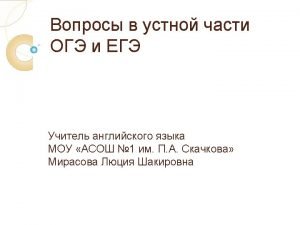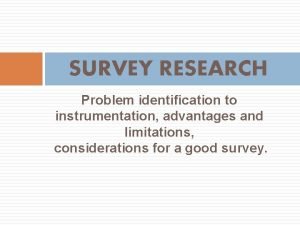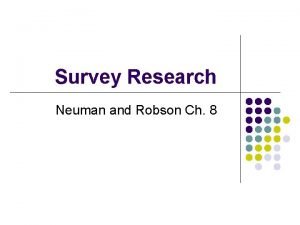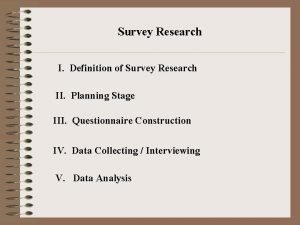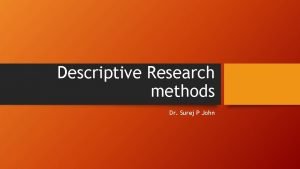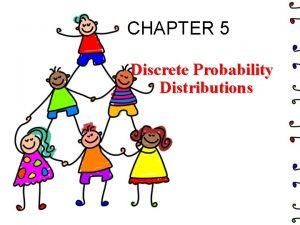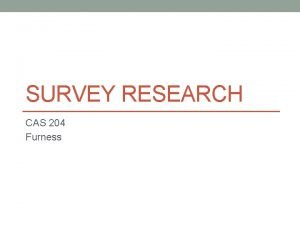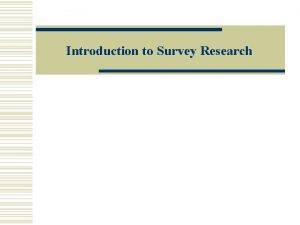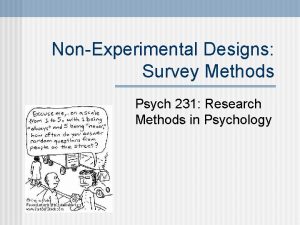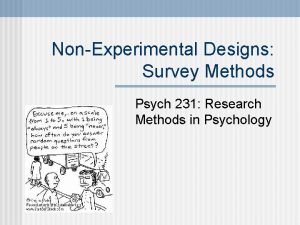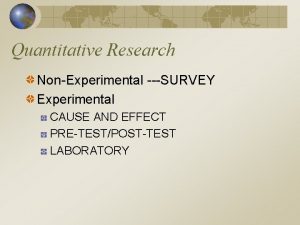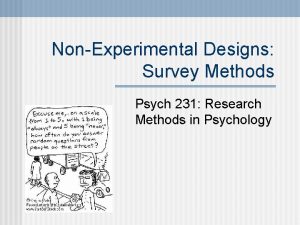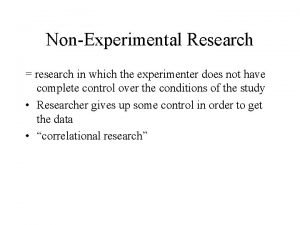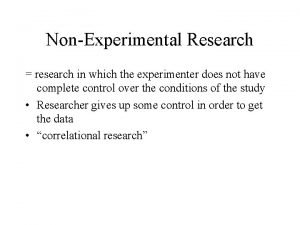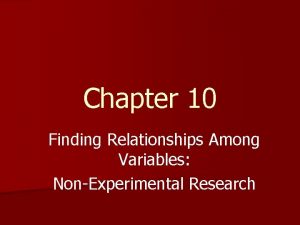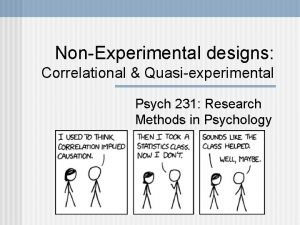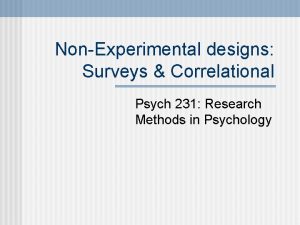Chapter 10 NonExperimental Research Part 2 Survey Research























- Slides: 23

Chapter 10 Non-Experimental Research, Part 2: Survey Research

How to Design a Questionnaire 1. Determine the Types of Questions • Open-ended Question – People can answer in their own words. • Example Sentence Completion: “I feel most betrayed when__________

How to Design a Questionnaire 1. Determine the Types of Questions • Close-ended Question – Answers limited to the choices available. [next slide example]

Psychological Entitlement Scale Please respond to the following items using the number that best reflects your own beliefs. 1 = strong disagreement 2 = moderate disagreement 3 = slight disagreement 4 = neither agreement nor disagreement 5 = slight agreement 6 = moderate agreement 7 = strong agreement ____I honestly feel I'm just more deserving than others. ____Great things should come to me. ____If I were on the Titanic, I think I would deserve to be on one of the first lifeboat ____Quite honestly, I feel I can demand the best because I'm worth it. ____I do not necessarily deserve special treatment. (reversed) ____I believe I deserve more things in my life. ____People like me deserve an extra break now and then. ____Things should go my way. ____I generally tend to feel entitled to more of everything. [discussion, next slide]

Discussion Points • What are the advantages and disadvantages of open ended versus closed ended questions? • Why do researchers change the direction of acknowledgement of items i. e. , reverse-score items i. e. , ____I do not necessarily deserve special treatment. (reversed) • Note how Likert Scale options are worded consistently using the same word stem (agreement) i. e. , “agreement” to “disagreement” • Video on nuclear power plant survey and bias

Writing Questionnaire Items • One issue per item (or question) • Example of bad item: • “I tend to react fearfully to dogs and become nauseous”. • Make closed-ended questions clear • Example of a bad item: • “How likely is it that you would volunteer? ”

Writing Questionnaire Items • Avoid Bias In Wording Response Options: • Example of Bias: • “To reduce insurance rates for all, should motorcyclists be required to wear helmets? ” VERSUS • “Should motorcyclists have the right to choose whether they wear a helmet or not? ” • Note: most survey questions are somewhat biased

Writing Questionnaire Items • Make sure your response options are mutually exclusive • no case can belong to more than one alternative at a time Example of a bad item: “Licenses should be required of: a) b) c) d) state forest recreational users those who hike or picnic in state forest land; campers on state forest land; those who fish or hunt on state forest land”

Writing Questionnaire Items • Make sure your response options exhaustive • all cases fall into one or another of the alternatives Examples: • cover all age groups of interest in survey • Cover all behavioral options (e. g. , sports activities)

Writing Questionnaire Items • Determine the format of the item • Closed-end formats • • Likert scale, check boxes branching items visual analogue scale • Space to write for open-ended questions • Sequence the items • Put things in the right order

Beware of… • Social Desirability • Stimulus items or options prompt the respondent to answer primarily in a socially desirable; these are uninformative items Examples: True/False • “I like to try to keep physically fit” • “I’ve never exaggerated the truth in telling any story” • Counter with a Verification Key • Also called a lie scale • Collection of items that detect dishonest answers • Examples: “I read every page of the newspaper each day” ; “I have never felt like swearing”;

Beware of… • Acquiescence • Tendency to agree with any statement • Example: Tendency to over-acknowledge nearly all items on an inventory of psychological problems • “Are you considerate of others? ” • “Are there times of the day in which you are extremely hungry? ” • Video on Sampling, Survey Research

Determine how to analyze the results • Determine Scoring • How will each question be represented in an analysis? • Use a Coding Guide to write it down • Examples: 1=always, 2=often, 3=rarely 4=never • 1. “I struggle finding the energy to get things done” (scored + • 2. “My energy level is adequate” (reverse scored) • Scoring convention for reverse scored items 1=4, 2=3, 3=2 4=1 • Compute Total = question 1 + reverse-scored question 2. • Example: • If less than 3 errors are present in the memory task, score a “ 0” • If 3 or more errors are present in the memory task, score a “ 1” • Example: • Code the following responses: 1=Anglo; 2= Latino/Hispanic; 3=Asian; 4=African-American

Determine how to analyze the results • Determine Scoring • Use a Coding Guide • Data Reduction and Transcription • Take care moving from individual sheets to analysis software • Computerized responses to computer database reduces scoring errors • Automated response system (recordings, Scantron forms)

Administration Logistics and Procedures • Methods of Survey Administration: Strengths, Weaknesses of Each Method? • Depends on “circumstances” e. g. , feasibility, available technology (wireless transmission of responses via phone), expense, risks to confidentiality • Face-to-Face: Strengths • Best rapport • Can influence motivation of respondent (for better or worse) • Assess understanding of questions asked

Administration Logistics and Procedures • Methods of Survey Administration: Strengths, Weaknesses of Each Method? • Depends on “circumstances” e. g. , feasibility, available technology (wireless transmission of responses via phone), expense, risks to confidentiality • Face-to-Face: Weaknesses • High expense of travel and time for live interviewers • Risk of influencing the responses because due to verbal, nonverbal cues from interviewer • Potential for interviewer effects is highest in F-to-F • Extensive training of interviewers is required

Administration Logistics and Procedures • Methods of Survey Administration: Strengths, Weaknesses of Each Method? • Written and/or Computer-based Formats • Advantages: • Much lower expense than face to face • Highly standardized, consistent presentation of questions • Research suggests more “honest” answers • Can offer some anonymity to respondents • Easier to code and score; create a data set of all responses • Group administrations, written format are very economical, with computerized (internet-based) systems the least expensive of all

Administration Logistics and Procedures • Methods of Survey Administration: Strengths, Weaknesses of Each Method? • Written and/or Computer-based Formats • Disadvantages: • Paper and pencil methods require handling, erasure marks, having to “hand in” a response form (i. e. , possible damage, missed answers • Reading level of respondent? • Lower response rates (by 25 -80%) with written and/or computer-based formats • Erroneous answers---respondent may uniformly answer all questions the same way to quickly finish the task

Administration Logistics and Procedures • Methods of Survey Administration: Strengths, Weaknesses of Each Method? • Telephone • Advantages: Similar to live interviews, but lower expense • Use of “call centers”, lower social pressures compared to face-to-face on interviewee • More training required compared to written or computer-based response systems

Response Rate Issues • Response Rate: The percentage of individuals who return the completed survey • Selection of stratified, random sample is undermined by the issue of “who, among the selected participants, actually elect to complete the survey” • Elective “magazine polls” or elective internet-based surveys have worst response rate, most biased sampling (response rates of 1 -2%) • Mail-in and Paper and Pencil surveys 10 -50) • Elective, in-class research surveys in college have 4060% return rate, on average

People & Surveys • Population • All of the people or animals in the group involved in the research • Sample • Sub-group of the population. • May be selected in several different ways: • • Haphazard sample Purposive sample Convenience sample Probability sample

Random Sample • Type of probability sample • Each member of the population has the same chance to be chosen, independently of any other member • A special type of random sample in which at least 2 subgroups are represented in the same proportions as the population is called a Stratified Random Sample.

Non-Random Probability Samples • Systematic sample • Used for practical reasons • Likelihood of any element being selected is still known • Cluster sample • Groupings from a larger population • Multistage sampling • Clusters further broken down by taking samples from each cluster
 Experimental vs nonexperimental research
Experimental vs nonexperimental research Nonexperimental study
Nonexperimental study Abcd survey
Abcd survey Take part in a telephone survey
Take part in a telephone survey Sinai bible
Sinai bible Chapter 2 parts of research
Chapter 2 parts of research Addition symbol
Addition symbol Part to part ratio definition
Part to part ratio definition Brainpop ratios
Brainpop ratios Technical description
Technical description It is the heart of the entire beverage operation
It is the heart of the entire beverage operation The part of a shadow surrounding the darkest part
The part of a shadow surrounding the darkest part Two way anova minitab 17
Two way anova minitab 17 Research instrument example
Research instrument example Advantages of survey research
Advantages of survey research Survey research definition
Survey research definition What is descriptive survey design
What is descriptive survey design Descriptive survey
Descriptive survey Advantages of survey research
Advantages of survey research A survey from teenage research unlimited found
A survey from teenage research unlimited found Survey the literature
Survey the literature Descriptive survey research design
Descriptive survey research design Advantages of cas
Advantages of cas Steps in survey research
Steps in survey research



